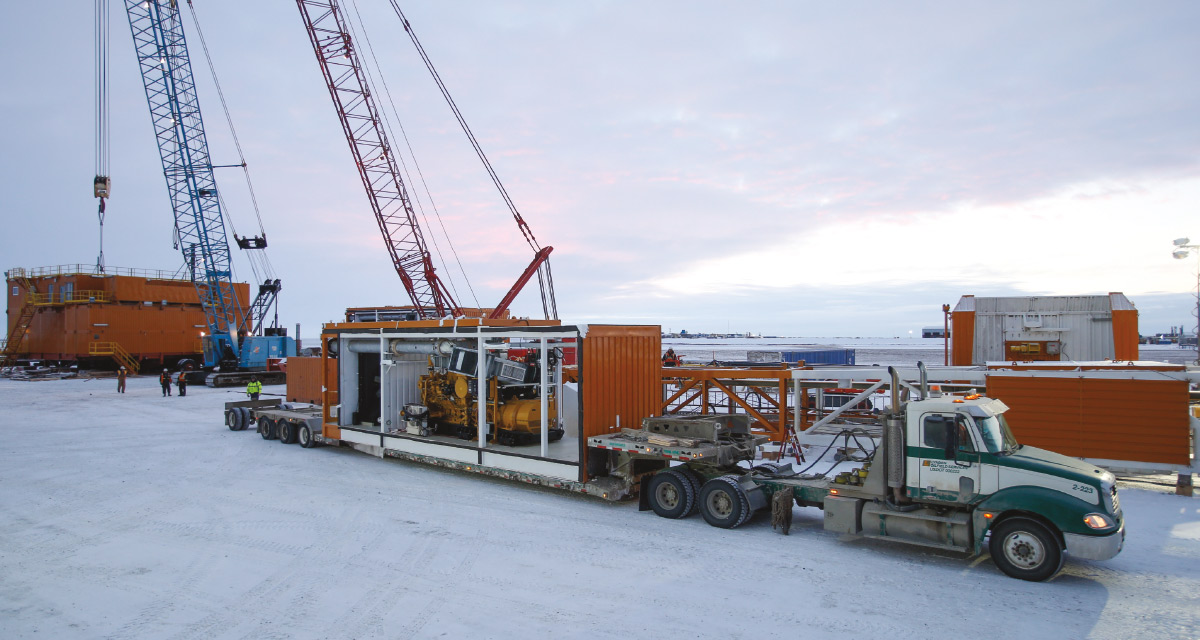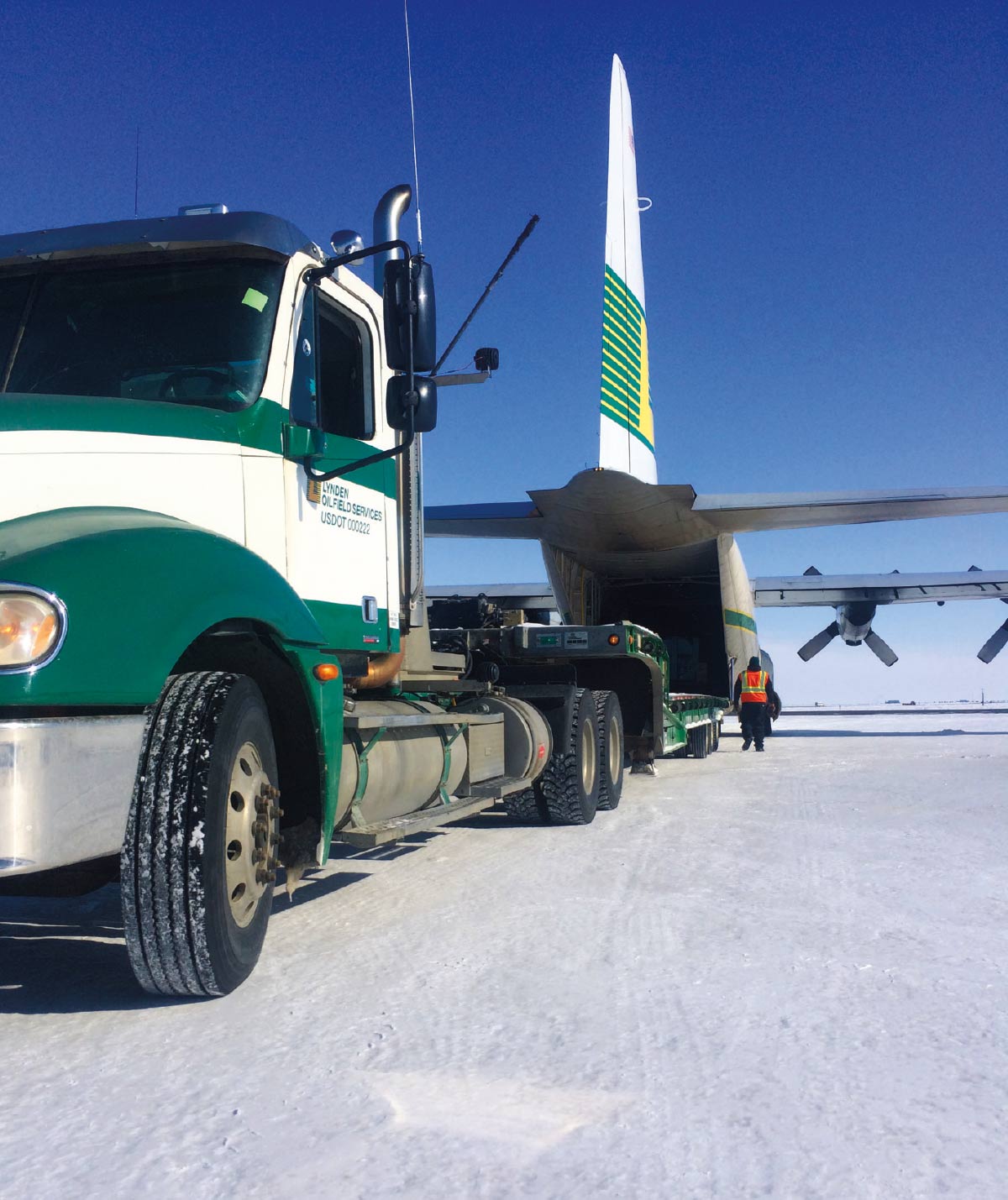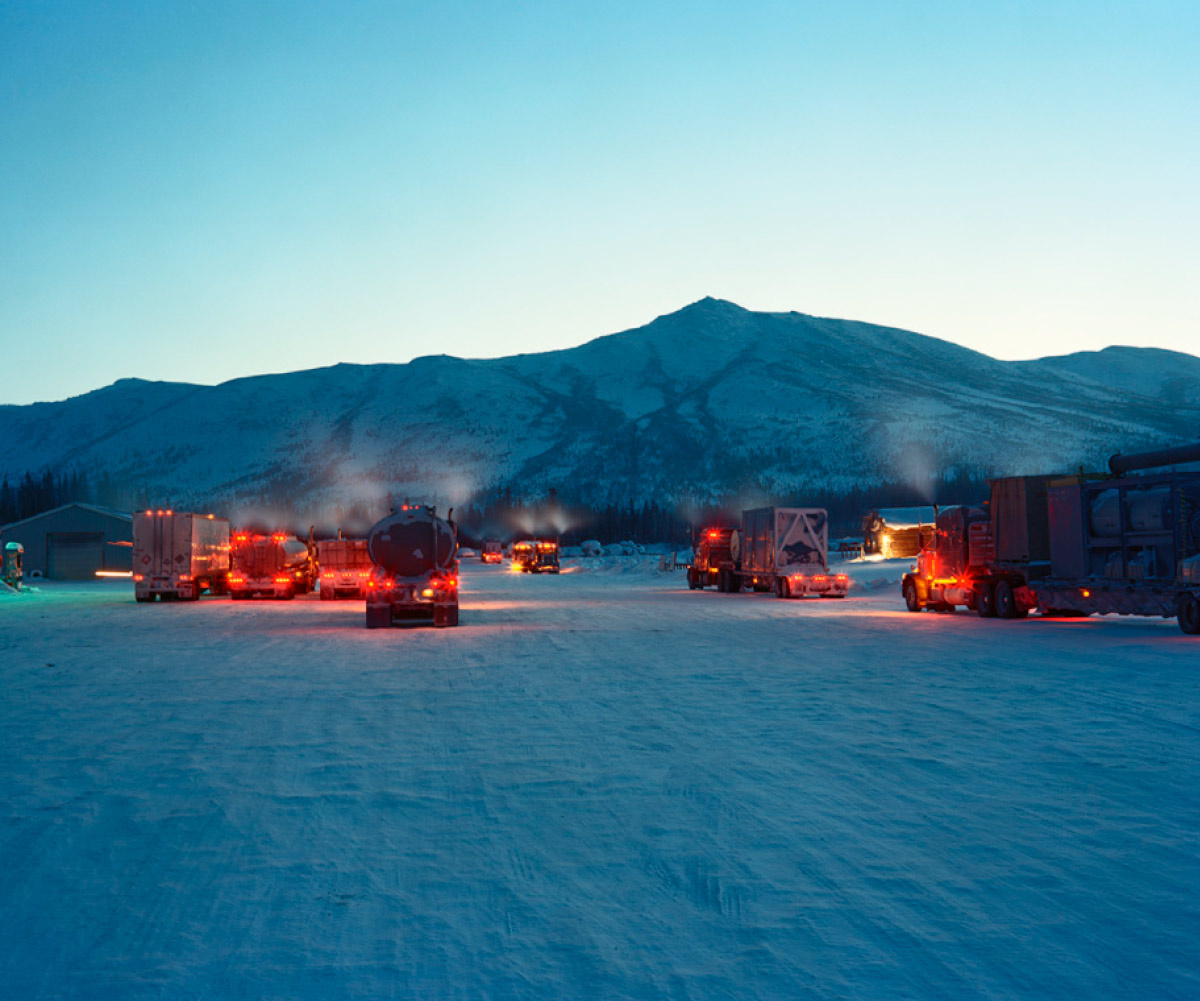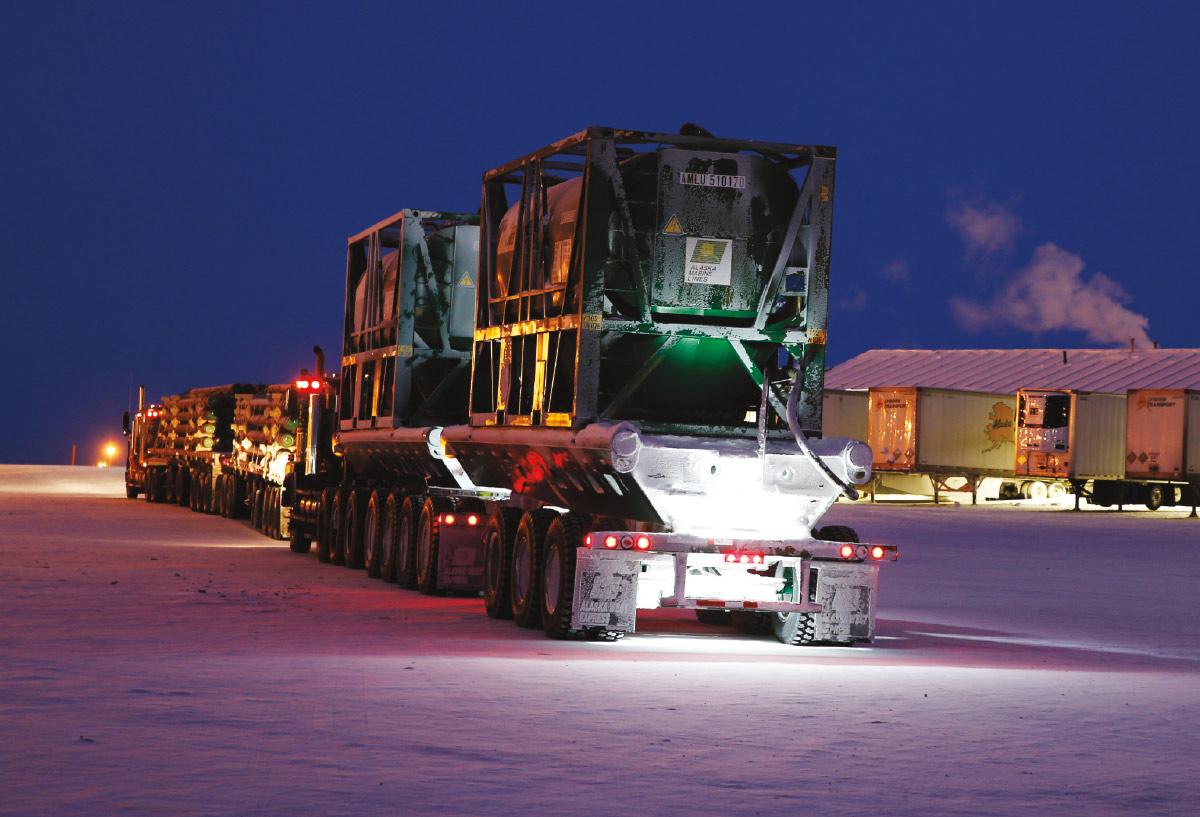ong haul truck drivers are a unique breed. But those navigating the northernmost highway in the United States transporting supplies to the Prudhoe Bay oil fields occupy a much loftier position.
The adventure begins when truckers start their trek up the 414-mile road from Livengood (2020 census population 11 residents) 84 miles north of Fairbanks—and ends a few miles short of the Arctic Ocean in Deadhorse and Prudhoe Bay.
Maps refer to it as the Dalton Highway or Alaska Route 11. Truckers call it the North Slope Haul Road.
Construction began on the mostly gravel road in 1974 during construction of the Trans Alaska Pipeline System. Completed in just five months, the road runs parallel to the northernmost section of pipe and includes seven pump stations. The highway was named after James William Dalton, an arctic engineer involved in early oil exploration on the North Slope.
The primitive road’s twists, turns, and potholes in summer, and ice, drifting snow, and temperatures dipping to -60˚F in winter provides challenging driving conditions for the most seasoned drivers. Add to the mix numerous steep grades, a climb to 4,800 feet over Atigun Pass in the Brooks Range, tourists, hunters, and the proverbial summer road construction.
The road opened to the public in 1994, but the adventure ends for casual travelers at Deadhorse as they are not allowed to enter the oil fields.
Road-side services are limited or non-existent, with fuel available only at the E.L. Patton Yukon River Bridge, Coldfoot at about the halfway point, and Deadhorse.
Despite the remoteness and treacherous driving conditions, the highway supports a group of experienced die-hard truckers working for a vast array of companies and conforming to a range of safety standards who staunchly look out for one another.
“Everybody looks out for each other,” says William Burke, vice president of operations for US Foods Alaska, a foodservice distributor supplying North Slope businesses. “There is a sense of camaraderie with all of the drivers who drive the road. Our drivers have told me countless stories where they have helped other drivers from other companies, as well as had other company drivers help them.”
And that assistance can lift drivers out of some nasty situations.
“There are two types of truck drivers on the Haul Road: Those who have been in the ditch and those who are going,” says retired trucker Kenny Seipel, who ran the Haul Road for thirty years.
“It’s not if, it’s when,” says Del Shagen, who drives for Alaska West Express pulling five axle tankers typically filled with 10,000 gallons of fuel or chemicals used in drilling.
Shagen recalls being run off the road several years ago by a tractor-trailer driver who lost control on the icy roads.
“I was very fortunate,” says Shagen. “Took it to the shop with a little minor body damage and [I was] on the road the next day.”
Shagen owns his truck and leases it to Alaska West Express as an owner/operator, in contrast to being a company driver.
“I basically own my own business,” Shagen says. “I pull their trailer, their loads. I’m more independent and make a bit more money and have more expenses.”
Shagen’s week typically starts in Anchorage where he hooks onto his load that has arrived at the port by tanker from the Lower 48. Other shipments go to Fairbanks by railcar where Shagen picks up his second or third load after delivering to Prudhoe Bay and returning down the Haul Road.
The 51-year-old Anchorage resident says he enjoys his job and relishes the freedom that comes with it.
“You’re on the road two days out of Fairbanks and you come back and you can do it again if you want,” Shagen adds.
Alaska West Express is part of the Lynden family of companies, which employs approximately 200 drivers and mechanics in central Alaska with roughly half of those employees supporting freight movement north of Fairbanks, according to Alaska West Express President Eric Badger.
The Lynden family of companies has a long history of supporting the oil and gas industry on the North Slope.
“We regularly truck heavy haul and oversized loads such as camp modules, process modules, drill rigs, pipe, bulk liquids, and bulk dry product to the North Slope from locations around the world,” Badger says.
To help support operations on the North Slope, Lynden has a terminal in Deadhorse where their drivers drop their loads and on-site staff delivers it to the appropriate customer location. “We have both the equipment and experienced on-site staff to ensure logistics—including last mile services—are completed efficiently and according to plan,” he says.
Lynden

Lynden
The regulation further states truckers must take ten hours off after each fifteen-hour haul, so time is money.
Gone are the days of paper logbooks that relied on what information the driver recorded. Now electronic logbooks attached to the truck’s engine document exactly how long that driver has been traveling–or not.
Gary Healy is a company driver for Alaska West Express based out of Fairbanks who normally starts his trips in the wee hours of the morning while his family is still asleep.
Drivers with heavy-haul and oversize loads aren’t always able to make the trip between Fairbanks and Prudhoe Bay in fifteen hours, while Healy can usually make a chemical load haul in eleven or thirteen hours.
Lynden

Lynden
Ben Huff | The Last Road North
Ben Huff | The Last Road North

Drivers do their ten hours resting in their truck’s sleeper either in the company yard at Prudhoe Bay or in many of the pullouts along the Haul Road.
In addition to commercial vehicle licenses and endorsements for hazardous material or the ability to pull double and triple trailers, new drivers also receive Haul Road training.
Depending on how green they are, new drivers can be required to do ten trips with an experienced hand, Tate says.
“We might keep them local for a few runs to see how they’re doing and their performance in the truck,” says Tate.
“Driving the Dalton Highway requires extensive experience to ensure everything is done safely,” emphasizes Badger. “Drivers must have all of the required training by regulations, as well as the North Slope training requirements. We don’t hire new drivers and turn them loose to go North, unless they are a known Dalton Highway driver, and even then, we still require them to convoy with our other experienced drivers for a period of time.”
Lynden
Lynden

Faith Meeker, a dispatcher for Carlile Transportation based in Fairbanks, uses that information to keep track of her drivers and how many trips they’ve done so she knows who is available for the next haul.
“I try to create some sort of work/life balance for the drivers,” Meeker says.
But things don’t always turn out as planned.
Drivers who find themselves sitting on the side of the road because of accidents, breakdowns, or weather events don’t have to see their fifteen hours eaten away, says Alaska West Express dispatcher Cody Tate.
Tate says there are several electronic logbook options where drivers are able to change their duty status, such as “on duty and not driving.”
Drivers aren’t the only ones working long hours: dispatchers have their own vital work to do.
Scheduling all the trucks, making sure the workload is continuous and nothing gets delayed—especially during ice road season—and prioritizing freight are some big challenges, Tate says.
“We have a relatively short ice road season when a lot of freight moves to the North Slope, so we spend a lot of time focused on logistical planning to ensure we make the most of that window,” says Badger. “Once the roads start thawing, usually sometime between March and June, weight restrictions are put in place that can reduce the allowable weight by up to 50 percent.”
Carlile trucks are equipped with a device called PeopleNet, according to Vice President of Operations Jeremy Miller.
“This device is connected to the truck and supported with satellite connectivity,” he says. “It allows our drivers to contact us if they have any issues. Cell phone coverage has also improved greatly over the past few years, and there are far less locations along the Haul Road that don’t have cellular coverage.”
Truckers keep close track on CB Channel 19 for state maintenance equipment that might be operating on the road, especially in winter.
State crews water down the highway in winter to make it smoother and keep finer parts of gravel from getting blown into the ditches, Healy says.
“Road maintenance operators are often looking down, and you don’t want to go by them too fast,” he adds. “Everybody knows where the equipment is. You don’t want to go around a corner and get surprised or drop off a hill and get surprised.”
Losing that chain of communication can instill fear in the toughest of drivers.
Shagen was running with several other truckers during a blizzard with 50 mile-per-hour winds and 15-foot visibility when his alternator died and he lost all electrical power. Stalled in the middle of the road, he knew his chances were high of either getting hit or freezing, and if his fuel gelled, he would be unable to start his truck.
It took him 45 minutes to change out the alternator: getting his truck hood up in the howling wind took the greatest amount of time. And it was a struggle getting his truck started, but it fired.
Summers bring dust and mud, with freezing rain and hurricane-force winds in winter, Healy says.
State maintenance crews put calcium chloride on the roads in the summer to control dust, but rains make it super muddy–sometimes worse than ice and snow, he adds.
“I’ve had to chain up for mud and it’s still hard to steer, so I have had to also put chains on the front axle,” Healy says.
Weather patterns seem to be changing, bringing more freezing rain in winter, he says.
Truckers hauling anything that catches a side wind on icy roads with no traction could find themselves in the wrong lane and their trailer in the other lane, trying to maneuver down the road without getting shoved into the ditch.
Meeker recalls a bad winter storm and avalanche a couple years ago on New Year’s Eve that had drivers sitting at Atigun Pass for three days because the blow was so hard and maintenance crews couldn’t get the road cleared.
But drivers come prepared.
Most trucks have very large fuel tanks that will get them to Prudhoe Bay and back with enough reserve to keep their trucks running in the event they get stuck for a few days, Meeker says.
“All [Carlile] sleeper cabs have auxiliary power units that run on less fuel to keep drivers warm in winter or cool in summer if they’re stuck somewhere,” she adds.
According to Badger, “All of our drivers, including our independent contractors, stay in the sleeper cabs of their trucks: it’s their home away from home. And all of our drivers pack with them the necessary cold weather gear and safety supplies for arctic conditions.”
And even in ideal conditions, the road isn’t easy. Some loads are so oversized and so overweight, they need several push trucks to help them up a steep grade.
In those instances, Meeker says Carlile’s heavy haul team gets called in to gauge the load and determine what kind of equipment is going to be needed.
“If it’s super wide and super heavy, they’ll do the math to figure out how many push trucks will be needed,” says Meeker. “A lot of times we will have loads that will have three or four push trucks behind it pushing up hills.”
No matter who is working or what they’re hauling, everyone works together on the Haul Road.
Alaska West Express’ Badger says, “All of the drivers and the companies operating on the Dalton are part of a big family, and we all look out for each other and provide support if there is an issue.”
“We’re a tight knit group,” Healy says of his fellow truckers. “We just want to make sure everybody gets home safe.”
As Tate says, “The oil field never stops. That means we don’t stop.” ![]()